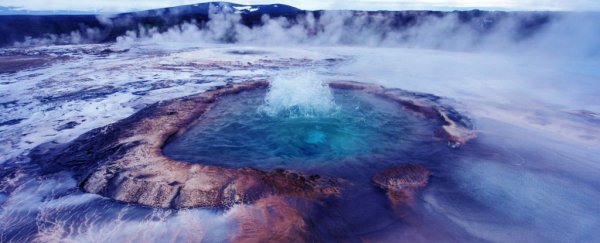If classic monster movies and old science experiments are to be believed, life begins with a spark.
Not everybody is convinced by this kind of origin story, so the search continues for sources of energy capable of transforming a prebiotic soup into a life-generating dish. Maybe the secret ingredient isn't anything more shocking than a pinch of salt.
A new study led by researchers from the Earth-Life Science Institute (ELSI) at Tokyo Institute of Technology in Japan has turned their attention to common old sodium chloride as a potential conduit for the chemical energy required for early biochemistry.
Sodium chloride consists of a 1:1 ratio of sodium and chloride ions, and in this case, it's the chloride ions that could be responsible. Once they've been given a dose of intense electromagnetic radiation, that is.
The origins of life on Earth have captivated our interest since forever.
Science has done a pretty good job of explaining how life has evolved to such a degree of diversity. We can use explanations such as natural selection to rewind the clock only so far, though.
At some point we need to leap from a chaotic swirl of organic chemicals to imperfectly replicating codes that might qualify as the very first glimmer of life; the first ecosystem, commonly referred to as the RNA world hypothesis.
Unfortunately, this whole hypothesis involves a bit of a chicken and egg problem.
Life relies on taking in energy from one source – whether it's in the form of chemical bonds or sunlight – and using it to rearrange compounds. Without a source of energy, we couldn't expedite the production of base chemicals responsible for making up primitive genetic codes.
While all modern organisms inherit the necessary cellular machinery, the first metabolic leap had to be a more ubiquitous source. Something simpler found not in life, but in the environment.
In the early 1950s, two chemists named Stanley Miller and Harold Urey famously generated a number of amino acids from simpler materials, demonstrating for the first time that the base materials for proteins didn't necessarily require a living source.
The supplied a voltage to their medium, assuming early Earth would have had a generous flow of current in the form of lightning strikes.
Even if this process did churn out amino acids, RNA is made up of a different alphabet of base chemicals. Working out how they were generated has also posed an energy problem.
Last year, a team of researchers proposed plasma from the shock waves rippling out of asteroid impacts could have provided sufficient grunt to convert organic building blocks into formamide – a parent molecule for the four RNA letters.
Part of the problem of dramatic events such as asteroid strikes and lightning bolts is they do a reasonable job of explaining the production of a small handful of key players. Meanwhile, there's a whole range of other chemicals that might have had supporting roles, which also need a back story.
This new study steps back a little further to include the story of a wider cast also considered to be essential to the life-generating cascade of reactions. One such example is a compound called cyanamide.
Earlier work by other researchers traces paths from compounds such as hydrogen cyanide to the fundamental RNA starting blocks under the presence of little more than UV light. But the generation of cyanamide was required, and that was one chemical nobody had accounted for.
"Our aim, therefore, was to develop a reaction network that produces simple sugars as well as cyanamide, and thereby many important precursors particularly for RNA synthesis in 'one-pot'," the researchers write in their report.
After analysing the chains of reactions driven not by UV light, but the more intense gamma radiation, they noticed cyanamide levels climbed in proportion with a rather surprising reagent - chloride ions.
Of the two ions contained in salt, it's usually sodium that gets all the attention, and its chloride counterpart, which rarely takes part in reactions, tends to get overlooked.
It seems in this case, being irradiated by gamma rays loosens the chlorides' electrons, providing the mixture with the energy necessary for cyanamide to form.
In some ways, this sounds more complicated (and less exciting) than lightning strikes and shock waves. But life needn't have started with a boom.
It might have just sizzled into existence with a generous dash of spice.
This research was published in ChemistrySelect.
